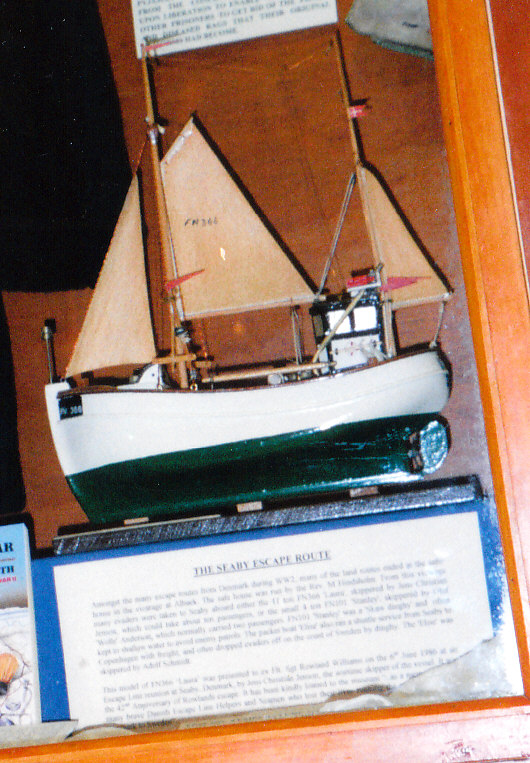A former member of the former RAFES, and a member of ELMS from the early days, Rowland Williams had been a Mustang pilot during WW2. On the night of 17 September ‘44, he was carrying out a daylight attack on enemy aircraft near Aalborg, in Denmark. The attack was successful; Rowland ‘downed’ two enemy aircraft, and disabled another two that had been sent up to engage him. During his attack on the fourth aircraft, his own aircraft was hit and, too low to parachute, Rowland made a forced landing in a field, where the Mustang collided with a power line.
Although shaken, Rowland quickly abandoned his aircraft and dived into a water-filled ditch, from where he observed German troops racing towards his aircraft; some also searched the nearby farm buildings. Once the Germans had left Rowland crawled from the ditch, soaking wet, then headed for one of the nearby barns where he hid in a loft full of grain. He reasoned that as the barn had just been searched the Germans would probably not be back for 24 hrs.

After a short time the farmer’s wife visited the barn accompanied by her ‘very suspicious’ dog. Rowland made himself known, and the lady left the barn. A short time later a farm hand appeared and, in sign language, indicated to Rowland to follow him. A new, more secure, hiding place was offered, high up behind a large water tank. Shortly afterwards, a German patrol arrived with more men and the farm was searched again. The grain loft was searched, but not the new hiding place. After the departure of the search party the farmer, Thorvald Aaen, provided Rowland with sandwiches and water while they studied maps of the area. Rowland decided to leave and head towards Frederickshaven.
Striking out on his own, Rowland sought further refuge in farm barns. Once again he was detected by a farm dog, this time one belonging to farmer Knud Nyholm Callisen, who took him into the large farmhouse and provided a very hearty breakfast. Once again local and country maps were brought out and, more importantly, an English/ Danish phrasebook. The family impressed upon Rowland that he should head towards the Albaek Vicarage, at Saeby, and not in the direction that he had originally intended. Rowland was later to discover that Saeby was the focal point for an escape route to Sweden, and the Vicarage its main safe-house.
Heading north, Rowland found difficulty crossing guarded bridges. However the problem was daringly solved with the assistance of Danish forced labourers who offered him lifts on German trucks [driven by German soldiers!]. As the vehicles slowed down or stopped, Rowland was hauled in, or out, of the back. It was while travelling on the back of one of these vehicles that Rowland observed his own aircraft being taken away on the back of another truck!
Rowland continued heading north, again hiding in barns. As usual, the scourge of escapers and evaders, the farm dog, announced his presence, but thankfully, with the aid of his phrasebook, he was able to communicate to the farmers who appeared that he was a downed RAF pilot. More families took him into their homes and provided more hearty breakfasts and assistance.
As Rowland travelled on by night and slept up during the day he became aware that his shoes [he had not worn his boots] were not the ideal choice for walking. His feet had become badly blistered. At Bigum, he was given shelter with the Munk family who, on seeing the state of his feet, promptly sent for Knud Repholtz, the local doctor, who arrived accompanied by his step-son Walter Lonsdale. Lonsdale worked with the Danish Resistance and, more importantly, spoke English.
Rowland now found himself in the hands of the Resistance, which worked with the Saeby Escape Line, and his onward route was organised for him. His feet were given treatment, he was given food and a bed for the night, and next day a courier arrived to take him by train to Aarhus and a local safe-house run by Lasse Egebjerg. He was given the identity of a deaf and dumb basket maker and an ID card. Next he was moved on to another safe-house at Aalborg, then taken by motor cycle to Albaek, and the local Vicarage, the location he had been directed to by the Callisen family.
From here, Rowland was taken to the fishing village of Saeby and another safe-house. On the evening of Monday 05th June 1944, at 2100hrs, he boarded the fishing boat ‘Laura’ skippered by Jens Christian Jenson, and arrived in Gothenburg on Tuesday 06th June 1944, where he learned of the Allied invasion of Europe. From Gothenburg Rowland was flown to Scotland and returned to his Squadron. After three weeks leave he took part in operations over Normandy. Rowland Williams DFC, died on the 05th March 2008; his story, together with a model of his fishing boat the ‘Laura’, are on display at Eden Camp Museum, North Yorkshire.

